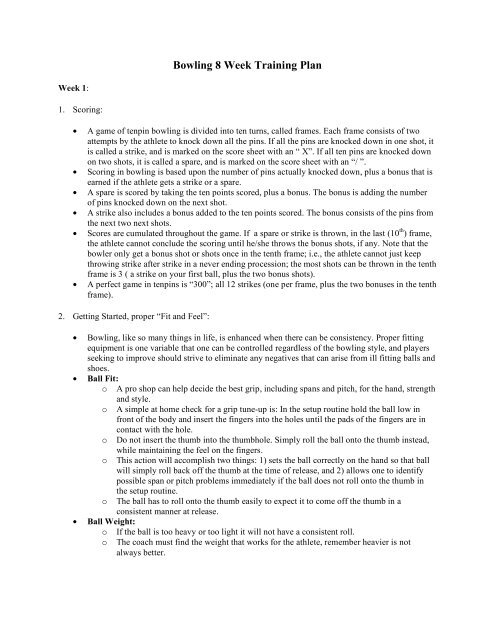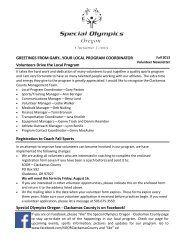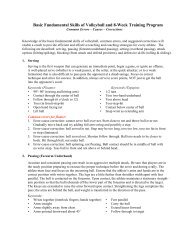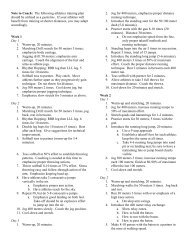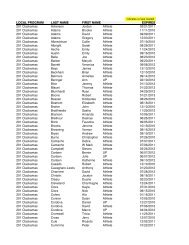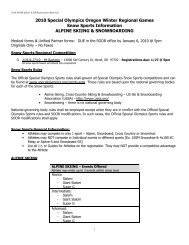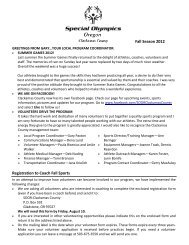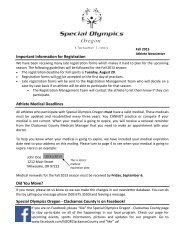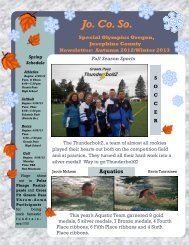Bowling 8 Week Training Plan
Bowling 8 Week Training Plan
Bowling 8 Week Training Plan
You also want an ePaper? Increase the reach of your titles
YUMPU automatically turns print PDFs into web optimized ePapers that Google loves.
<strong>Bowling</strong> 8 <strong>Week</strong> <strong>Training</strong> <strong>Plan</strong><br />
<strong>Week</strong> 1:<br />
1. Scoring:<br />
• A game of tenpin bowling is divided into ten turns, called frames. Each frame consists of two<br />
attempts by the athlete to knock down all the pins. If all the pins are knocked down in one shot, it<br />
is called a strike, and is marked on the score sheet with an “ X”. If all ten pins are knocked down<br />
on two shots, it is called a spare, and is marked on the score sheet with an “/ ”.<br />
• Scoring in bowling is based upon the number of pins actually knocked down, plus a bonus that is<br />
earned if the athlete gets a strike or a spare.<br />
• A spare is scored by taking the ten points scored, plus a bonus. The bonus is adding the number<br />
of pins knocked down on the next shot.<br />
• A strike also includes a bonus added to the ten points scored. The bonus consists of the pins from<br />
the next two next shots.<br />
• Scores are cumulated throughout the game. If a spare or strike is thrown, in the last (10 th ) frame,<br />
the athlete cannot conclude the scoring until he/she throws the bonus shots, if any. Note that the<br />
bowler only get a bonus shot or shots once in the tenth frame; i.e., the athlete cannot just keep<br />
throwing strike after strike in a never ending procession; the most shots can be thrown in the tenth<br />
frame is 3 ( a strike on your first ball, plus the two bonus shots).<br />
• A perfect game in tenpins is “300”; all 12 strikes (one per frame, plus the two bonuses in the tenth<br />
frame).<br />
2. Getting Started, proper “Fit and Feel”:<br />
• <strong>Bowling</strong>, like so many things in life, is enhanced when there can be consistency. Proper fitting<br />
equipment is one variable that one can be controlled regardless of the bowling style, and players<br />
seeking to improve should strive to eliminate any negatives that can arise from ill fitting balls and<br />
shoes.<br />
• Ball Fit:<br />
o A pro shop can help decide the best grip, including spans and pitch, for the hand, strength<br />
and style.<br />
o A simple at home check for a grip tune-up is: In the setup routine hold the ball low in<br />
front of the body and insert the fingers into the holes until the pads of the fingers are in<br />
contact with the hole.<br />
o Do not insert the thumb into the thumbhole. Simply roll the ball onto the thumb instead,<br />
while maintaining the feel on the fingers.<br />
o This action will accomplish two things: 1) sets the ball correctly on the hand so that ball<br />
will simply roll back off the thumb at the time of release, and 2) allows one to identify<br />
possible span or pitch problems immediately if the ball does not roll onto the thumb in<br />
the setup routine.<br />
o The ball has to roll onto the thumb easily to expect it to come off the thumb in a<br />
consistent manner at release.<br />
• Ball Weight:<br />
o<br />
o<br />
If the ball is too heavy or too light it will not have a consistent roll.<br />
The coach must find the weight that works for the athlete, remember heavier is not<br />
always better.
<strong>Week</strong> 2<br />
1. Establish a Balanced Starting Point – It is important for a bowler to have the same starting position<br />
each and every time. Listed below is a mental checklist for the athlete:<br />
• Are the feet properly placed – front to back, as well as side to side<br />
• Are the feet about 1” apart with the toe and the ball even with the instep of my sliding foot<br />
• Are the knees relaxed and bent slightly<br />
• Is the upper body relaxed; is the ball side shoulder slightly behind the sliding side shoulder<br />
• Is the ball in the proper position height wise<br />
• Are the ball side shoulder, elbow, wrist and index finger all in line<br />
• Is the thumb at 10-11 o’clock<br />
• Are the shoulders parallel to target line, not necessarily the foul line<br />
The goal as bowlers is to have a consistency to the approach and delivery to maximize the potential to<br />
make shot after shot the same; the consistency begins on the approach before the first step. It is very<br />
difficult to have a consistent finish without a consistent beginning.<br />
2. Alignment using the athlete’s personal number:<br />
• The athlete’s personal number is based on his (normal walk pattern) (how far you release the ball<br />
from your slide foot).<br />
• First, stand on board 20 ( all alignments are made using the inside of the left foot); walk in a<br />
normal delivery, feet parallel to the boards, and make a straight “ up the boards ” delivery; stop,<br />
look at where your left foot is after the slide; do this five times.<br />
3. Computing your athlete’s personal number:<br />
• If the athlete drifts right, add the number of boards of drift to the number of boards the athlete<br />
releases the ball from the left foot. Example, if there is a 2 board drift right the personal number is<br />
9.<br />
• If drift left, subtract the boards of drift from the number of boards the ball is released from your<br />
left foot. Example, if there is a 2 board drift left the personal number is now 5.<br />
<strong>Week</strong> 3<br />
1. Establish a target spot.<br />
• Warm up until the athlete is comfortable with speed and balance.<br />
• Play any line that feels close for the normal lane condition.<br />
o<br />
o<br />
o<br />
o<br />
If one hits the target light, move 2 boards right with feet.<br />
If one hits flush nose, move 2 boards left with feet.<br />
If there is a heavy crossover, move 4 boards left with feet.<br />
If there is a far crossover, move 6 boards left with feet.<br />
<strong>Week</strong> 4<br />
1. Balanced Finishing Position and Spare Practice
• Slightly bend legs at the knees.<br />
• Body bent at the waist, not leaning forward.<br />
• Trail foot toe on the ground.<br />
• Free swinging pendulum follow through along the target line; extend, hold the arm swing at the<br />
target. One must have a free swinging pendulum that can reach, extend, return, reach, extend,<br />
return.<br />
2. Spare Practice<br />
• The fastest way to improve one’s average is to pick up spares. One extra spare in a three game<br />
series would increase the athlete’s average by 3.3 pins, without any more strikes. Consistency of<br />
release, accuracy, pocket shooting will increase the athlete’s average. A game that can be played<br />
to increase the spare pick ups is called SEVEN FRAMES.<br />
o Frame 1: 10 pin, shoot it until it is made twice; count how many shots it took to make it<br />
twice; that is the score for the frame<br />
o Frame 2: 6 pin, shoot it until its made twice; count how many shots it took to make it<br />
twice; that is the score for the frame<br />
o Frame 3: 3 pin, shoot it until its made twice; count how many shots it took to make it<br />
twice; that is the score for the frame<br />
o Frame 4: the pocket; Three practice shots are allowed to find the pocket; when it starts<br />
again, the target is the pocket (a strike is not necessary, just hit the pocket); shoot it until<br />
it is hit twice; count how many shots it took to hit it twice; that is the score for the frame<br />
o Frame 5: 2 pin; shoot it until it is made twice; count how many shots it took to make it<br />
twice; that is the score for the frame<br />
o Frame 6: 4 pin; shoot it until it is made twice; count how many shots it took to make it<br />
twice; that is the score for the frame<br />
o Frame 7: 7 pin: shoot it until it is made twice; count how many shots it took to<br />
make it twice; that is the score for the frame<br />
• Now total your score. A perfect score is 14. Keep a record of the score and make it a goal to get<br />
an average of 14.5-15; (b) Review the score in each frame; determine which basic type spare<br />
gives the athletes the most trouble and have them practice it.<br />
• The athlete can also use the 3-6-9 system for spare shooting, the system refers to the number of<br />
boards that the athlete moves from the normal strike line to convert a spare. This system assumes<br />
the ideal strike line that is working for the athlete.<br />
• LEFT SIDE SPARES: Move the feet to the right, keeping the target at the arrows the same.<br />
o 2 pin: move three boards<br />
o 4 pin: move six boards<br />
o 7 pin: move 9 boards<br />
• RIGHT SIDE SPARES: First establish the preferred shot at the ten pin. Remind the athletes that<br />
no system is perfect. Try this and then adjust the boards accordingly<br />
o 6 pin: move three boards right and throw the normal pin shot<br />
o 3 pin: move six boards right and throw the normal ten pin shot<br />
<strong>Week</strong> 5<br />
Same as week two and Individual work.
<strong>Week</strong> 6<br />
Same as week three and individual work.<br />
<strong>Week</strong> 7<br />
Same as week four and individual work.<br />
<strong>Week</strong> 8<br />
1. Put all skills together and have practice games without keeping score, just work on spares, target and<br />
angle adjustments, the athletes get better with practice and focus.<br />
2. Points to Ponder:<br />
• “You can never learn to bowl; you can only learn as you bowl. Never limit yourself to what you know.”<br />
• “With the right attitude, learning is continuous.”


